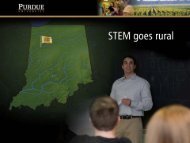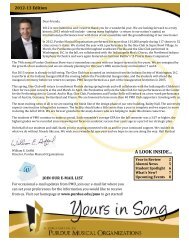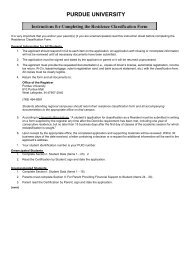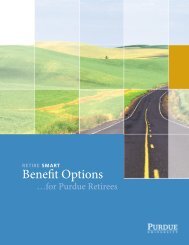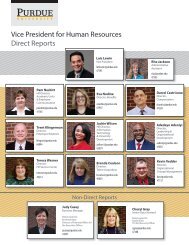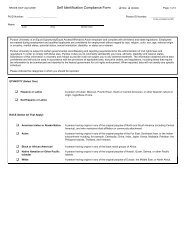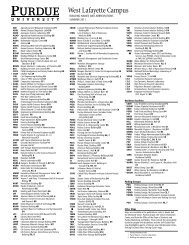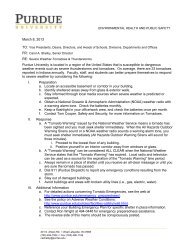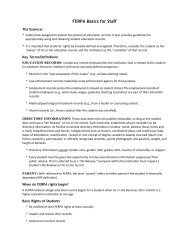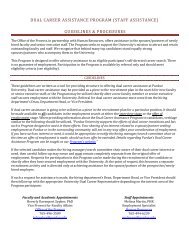Rockets Away with Newton's Laws of Motion - Purdue University
Rockets Away with Newton's Laws of Motion - Purdue University
Rockets Away with Newton's Laws of Motion - Purdue University
You also want an ePaper? Increase the reach of your titles
YUMPU automatically turns print PDFs into web optimized ePapers that Google loves.
<strong>Purdue</strong> GK-12 Lesson Plan 2006-07<br />
<strong>Rockets</strong> <strong>Away</strong> <strong>with</strong><br />
Newton’s <strong>Laws</strong> <strong>of</strong> <strong>Motion</strong><br />
<strong>Purdue</strong> <strong>University</strong> GK-12 Program 2006-07<br />
Lead developers and contacts:<br />
Carrie Davis Todd<br />
<strong>Purdue</strong> <strong>University</strong> GK-12 Fellow<br />
Department <strong>of</strong> Earth and Atmospheric Sciences<br />
DAVIS120@PURDUE.EDU<br />
Jody Riskowski<br />
<strong>Purdue</strong> <strong>University</strong> GK-12 Fellow<br />
Weldon School <strong>of</strong> Biomedical Engineering<br />
JRISKOWS@PURDUE.EDU<br />
Instructors:<br />
Patty Butler<br />
Frankfort Middle School Math Teacher<br />
BUTLERP@FRANKFORT.K12.IN.US<br />
Ryan Skinner<br />
Frankfort Middle School Science Teacher<br />
SKINNERR@FRANKFORT.K12.IN.US
Table <strong>of</strong> Contents<br />
1. OVERVIEW ..............................................................................................................................3<br />
2. PURPOSE ................................................................................................................................3<br />
3. OBJECTIVES ...........................................................................................................................3<br />
4. INDIANA EIGHTH GRADE STANDARDS MET .......................................................................4<br />
4.1. MATH.................................................................................................................................4<br />
4.1.1. STANDARD 2 – COMPUTATION ...............................................................................4<br />
4.1.2. STANDARD 3 – ALGEBRA AND FUNCTIONS...........................................................4<br />
4.1.3. STANDARD 5 – MEASUREMENT ..............................................................................4<br />
4.1.4. STANDARD 6 – DATA ANALYSIS AND PROBABILITY.............................................4<br />
4.1.5. STANDARD 7 – PROBLEM SOLVING........................................................................4<br />
4.2. SCIENCE ...........................................................................................................................5<br />
4.2.1. STANDARD 1 – THE SCIENTIFIC VIEW OF THE WORLD .......................................5<br />
4.2.2. STANDARD 2 – SCIENTIFIC THINKING....................................................................5<br />
4.2.3. STANDARD 3 – THE PHYSICAL SETTING................................................................5<br />
4.2.4. STANDARD 5 – THE MATHEMATICAL WORLD .......................................................6<br />
4.3. ENGLISH/LANGUAGE ARTS............................................................................................6<br />
4.3.1. STANDARD 4 – WRITING: PROCESSES AND FEATURES.....................................6<br />
4.3.2. STANDARD 5 – WRITING: APPLICATIONS .............................................................6<br />
4.3.3. STANDARD 6 – WRITING: ENGLISH LANGUAGE CONVENTIONS........................7<br />
5. METHODS AND TIMELINE......................................................................................................7<br />
5.1. MATERIALS & RESOURCES............................................................................................7<br />
5.2. PROCEDURES..................................................................................................................7<br />
5.2.1. PREPARATION...........................................................................................................7<br />
5.2.2. ORDER OF ACTIVITIES .............................................................................................7<br />
5.2.3. DISCUSSION AND FINAL THOUGHTS......................................................................8<br />
6. SCOPE .....................................................................................................................................8<br />
7. ACTIVITIES, WORKSHEETS, AND TEMPLATES...................................................................8<br />
7.1. VELO-CITY ........................................................................................................................8<br />
7.2. VELO-CITY PART II...........................................................................................................9<br />
7.3. ROOTIN’ TOOTIN’ NEWTON ..........................................................................................13<br />
7.4. CSI: FRANKFORT ...........................................................................................................13<br />
7.5. ROCKETS AWAY – SCIENCE ........................................................................................20<br />
7.6. ROCKETS AWAY – MATH ..............................................................................................22<br />
7.7. OCTOBER SKY ...............................................................................................................25<br />
8. EVALUATION.........................................................................................................................25<br />
9. REFLECTION/LESSONS LEARNED/ALTERATIONS FOR FUTURE USE ...........................25<br />
10. RESOURCES.......................................................................................................................26<br />
10.1. KENNEDY SPACE CENTER.........................................................................................26<br />
Frankfort – <strong>Rockets</strong> 2
1. Overview<br />
“<strong>Rockets</strong> <strong>Away</strong> <strong>with</strong> Newton’s <strong>Laws</strong> <strong>of</strong> <strong>Motion</strong>” covers the basics <strong>of</strong> Newton’s Three<br />
<strong>Laws</strong> <strong>of</strong> <strong>Motion</strong>, <strong>with</strong> a capstone activity <strong>of</strong> building and testing a water rocket. The<br />
lesson is intended to work across the team, incorporating science in Math, English and<br />
Social Studies. Even though the activity is structured around the team concept at the<br />
middle school level, the activities can act as stand-alone activities, and students <strong>with</strong><br />
little to no prior content knowledge would be able to complete each activity as they do<br />
not build on each other.<br />
In addition to the science concepts and scientific method in Science class, the unit<br />
includes the mathematical components <strong>of</strong> velocity determination, percent difference,<br />
and trigonometry. In English and Social Studies, there are writing components that<br />
require critical thinking skills and analysis <strong>of</strong> science concepts. There are approximately<br />
20 class periods needed for the activities across the Science, Math, English and Social<br />
Studies classes.<br />
2. Purpose<br />
The purpose <strong>of</strong> the unit and lessons were to help students to understand Newton’s<br />
<strong>Laws</strong> <strong>of</strong> <strong>Motion</strong> and to use the scientific method in rocketry sub-unit. Furthermore,<br />
incorporating all the class disciplines, English/Language Arts and Math to Science<br />
allows students to tie their knowledge to the other disciplines.<br />
This lesson was also developed <strong>with</strong> the intent that those <strong>with</strong> limited knowledge in<br />
force and motion would be able to successfully complete all activities.<br />
3. Objectives<br />
The objectives for this project were to:<br />
• Work through the scientific method, using it to maximize a parameter <strong>of</strong> interest.<br />
• Illustrate how science and Newton’s <strong>Laws</strong> can be used in everyday situations and<br />
movement.<br />
• Provide an opportunity for students to use critical thinking skills to develop and write a<br />
paragraph using science concepts, words and ideas.<br />
• Demonstrate how trigonometry and trigonometric ratios can be used to determine the<br />
height <strong>of</strong> a rocket.<br />
• Familiarize students <strong>with</strong> the mobile computers and the computer skills needed for<br />
using Excel to solve math problems and equations.<br />
• Analyze data by hand using measures <strong>of</strong> central tendency.<br />
• Discuss results by using proportions and percentages.<br />
• Interpret and discuss results.<br />
Frankfort – <strong>Rockets</strong> 3
4. Indiana Eighth Grade Standards Met<br />
4.1. Math<br />
4.1.1. Standard 2 – Computation<br />
8.2.1 Add, subtract, multiply, and divide rational numbers (integers, fractions, and<br />
terminating decimals in multi-step problems).<br />
4.1.2. Standard 3 – Algebra and Functions<br />
8.3.1 Write and solve linear equations and inequalities in one variable, interpret the<br />
solution or solutions in their context, and verify the reasonableness <strong>of</strong> the results.<br />
8.3.6 Find the slope <strong>of</strong> a linear function given the equation and write the equation <strong>of</strong> a<br />
line given the slop and any point on the line.<br />
8.3.7 Demonstrate an understanding <strong>of</strong> rate as a measure <strong>of</strong> one quantity <strong>with</strong> respect<br />
to another quantity.<br />
4.1.3. Standard 5 – Measurement<br />
8.5.1 Convert common measurements for length, area, volume, weight, capacity, and<br />
time to equivalent measurements <strong>with</strong>in the same system.<br />
8.5.2 Solve simple problems involving rates and derived measurements for attributes<br />
such as velocity and density.<br />
4.1.4. Standard 6 – Data Analysis and Probability<br />
8.6.3 Understand the meaning <strong>of</strong>, and be able to identify or compute the minimum<br />
value, the lower quartile, the median, the upper quartile, the inter-quartile range, and the<br />
maximum value <strong>of</strong> a data set.<br />
8.6.4 Analyze, interpret, and display single- and two-variable data in appropriate bar,<br />
line, and circle graphs; stem-and-leaf plots; and box-and-whisker plots and explain<br />
which types <strong>of</strong> display are appropriate for various data sets.<br />
8.6.5 Represent two-variable data <strong>with</strong> a scatterplot on the coordinate plane and<br />
describe how the data points are distributed. If the pattern appears to be linear, draw a<br />
line that appears to best fit the data and write the equation <strong>of</strong> that line.<br />
4.1.5. Standard 7 – Problem Solving<br />
8.7.9 Use graphing to estimate solutions and check the estimates <strong>with</strong> analytic<br />
approaches.<br />
8.7.11 Decide whether a solution is reasonable in the context <strong>of</strong> the original situation.<br />
Frankfort – <strong>Rockets</strong> 4
4.2. Science<br />
4.2.1. Standard 1 – The Scientific View <strong>of</strong> the World<br />
8.1.1 Recognize that and describe how scientific knowledge is subject to modification as<br />
new information challenges prevailing theories and as a new theory* leads to looking at<br />
old observations in a new way.<br />
8.1.3 Recognize and describe that if more than one variable changes at the same time<br />
in an experiment, the outcome <strong>of</strong> the experiment may not be attributable to any one <strong>of</strong><br />
the variables.<br />
8.1.4 Explain why accurate record keeping, openness, and replication are essential for<br />
maintaining an investigator’s credibility <strong>with</strong> other scientists and society.<br />
8.1.6 Identify the constraints that must be taken into account as a new design is<br />
developed, such as gravity and the properties <strong>of</strong> the materials to be used.<br />
4.2.2. Standard 2 – Scientific Thinking<br />
8.2.2 Determine in what units, such as seconds, meters, grams, etc., an answer should<br />
be expressed based on the units <strong>of</strong> the inputs to the calculation.<br />
8.2.3 Use proportional reasoning to solve problems.<br />
8.2.4 Use technological devices, such as calculators and computers, to perform<br />
calculations.<br />
8.2.6 Write clear, step-by-step instructions (procedural summaries) for conducting<br />
investigations, operating something, or following a procedure.<br />
8.2.7 Participate in group discussions on scientific topics by restating or summarizing<br />
accurately what others have said, asking for clarification or elaboration, and expressing<br />
alternative positions.<br />
8.2.8 Use tables, charts, and graphs in making arguments and claims in, for example,<br />
oral and written presentations about lab or fieldwork.<br />
4.2.3. Standard 3 – The Physical Setting<br />
8.3.5 Explain that everything on or anywhere near Earth is pulled toward Earth’s center<br />
by a gravitational force.<br />
8.3.13 Explain that energy cannot be created or destroyed but only changed from one<br />
form into another.<br />
8.3.15 Identify different forms <strong>of</strong> energy that exist in nature.<br />
Frankfort – <strong>Rockets</strong> 5
4.2.4. Standard 5 – The Mathematical World<br />
8.5.2 Show that an equation containing a variable may be true for just one value <strong>of</strong> the<br />
variable.<br />
8.5.3 Demonstrate that mathematical statements can be used to describe how one<br />
quantity changes when another changes.<br />
8.5.4 Illustrate how graphs can show a variety <strong>of</strong> possible relationships between two<br />
variables.<br />
8.5.5 Illustrate that it takes two numbers to locate a point on a map or any other twodimensional<br />
surface.<br />
8.5.9 Compare the mean, median, and mode <strong>of</strong> a data set.<br />
8.5.10 Explain how the comparison <strong>of</strong> data from two groups involves comparing both<br />
their middles and the spreads.<br />
4.3. English/Language Arts<br />
4.3.1. Standard 4 – Writing: Processes and Features<br />
8.4.2 Create compositions that have a clear message, a coherent thesis (a statement <strong>of</strong><br />
position on the topic), and end <strong>with</strong> a clear and well-supported conclusion.<br />
8.4.3 Support theses or conclusions <strong>with</strong> analogies (comparisons), paraphrases,<br />
quotations, opinions from experts, and similar devices.<br />
8.4.10 Create an organizational structure that balances all aspects <strong>of</strong> the composition<br />
and uses effective transitions between sentences to unify important ideas.<br />
8.4.5 Achieve an effective balance between researched information and original ideas.<br />
4.3.2. Standard 5 – Writing: Applications<br />
8.5.2 Write responses to literature that:<br />
• demonstrate careful reading and insight into interpretations.<br />
• connect response to the writer’s techniques and to specific textual references.<br />
• make supported inferences about the effects <strong>of</strong> a literary work on its audience.<br />
• support statements <strong>with</strong> evidence from the text.<br />
8.5.4 Write persuasive compositions that:<br />
• include a well-defined thesis that makes a clear and knowledgeable appeal.<br />
• present detailed evidence, examples, and reasoning to support effective<br />
arguments and emotional appeals.<br />
• provide details, reasons, and examples, arranging them effectively by<br />
anticipating and answering reader concerns and counterarguments.<br />
Frankfort – <strong>Rockets</strong> 6
8.5.5 Write technical documents that:<br />
• identify the sequence <strong>of</strong> activities needed to design a system, operate a tool, or<br />
explain the bylaws <strong>of</strong> an organization’s constitution or guidelines.<br />
• include all the factors and variables that need to be considered.<br />
• use formatting techniques, including headings and changing the fonts<br />
(typeface) to aid comprehension.<br />
8.5.6 Write using precise word choices to make writing interesting and exact.<br />
4.3.3. Standard 6 – Writing: English Language Conventions<br />
8.6.1 Use correct and varied sentence types (simple, compound, complex, and<br />
compound-complex) and sentence openings to present a lively and effective personal<br />
style.<br />
8.6.5 Use correct punctuation.<br />
8.6.6 Use correct capitalization.<br />
8.6.7 Use correct spelling conventions.<br />
5. Methods and Timeline<br />
5.1. Materials & Resources<br />
The materials required for this lesson are listed throughout the activity worksheets (see<br />
section 7).<br />
5.2. Procedures<br />
5.2.1. Preparation<br />
As a whole, this unit presents all the information necessary for students to become<br />
familiar <strong>with</strong> Newton’s <strong>Laws</strong> and to successfully complete the activities. Using any <strong>of</strong><br />
the sub-units as stand-alone activities, however, may require the students to have some<br />
level <strong>of</strong> understanding <strong>of</strong> basic physical concepts.<br />
5.2.2. Order <strong>of</strong> Activities<br />
For students to gain a background and understanding in Newton’s <strong>Laws</strong>, the first activity<br />
should be “Rootin’ Tootin’ Newton.” With the “Rootin’ Tootin’ Newton” activity and<br />
subsequent follow-up discussion, students can understand how the <strong>Laws</strong> <strong>of</strong> <strong>Motion</strong><br />
control all movements and are used in everyday life. The “CSI: Frankfort” activity is a<br />
good follow-up to allow students to use their knowledge <strong>of</strong> the <strong>Laws</strong> <strong>of</strong> <strong>Motion</strong> in a reallife<br />
setting as an accident investigator. This activity requires students to use their<br />
science vocabulary to describe how an accident occurred. “Velo-City” can be done after<br />
“Rootin’ Tootin’ Newton” to explore the how the math is involved in the <strong>Laws</strong> <strong>of</strong> <strong>Motion</strong>.<br />
Frankfort – <strong>Rockets</strong> 7
The October Sky writing prompt can be added at any time to allow students to explore<br />
their knowledge <strong>of</strong> Newton’s <strong>Laws</strong> and cinema. The culminating activity <strong>of</strong> the unit is<br />
the “<strong>Rockets</strong> <strong>Away</strong>” activity, which builds on the previous activities and knowledge. The<br />
“<strong>Rockets</strong> <strong>Away</strong>” activity is interdisciplinary between Math and Science, requiring both<br />
classrooms to dedicate at least a week for the activity.<br />
5.2.3. Discussion and Final Thoughts<br />
Some points for a wrap-up discussion include:<br />
• Relationships between forces, torque and motion<br />
• How Newton’s <strong>Laws</strong> can be applied to sport and activities<br />
• Importance <strong>of</strong> trials and multiple data collection<br />
6. Scope<br />
Activities for this unit may encompass one day to over a week. Additionally, most<br />
activities can be built upon to increase the depth and coverage <strong>of</strong> the topic or they can<br />
be decreased to limit the amount <strong>of</strong> time needed for the activities. The Science and<br />
Math portions <strong>of</strong> the rocket unit (“<strong>Rockets</strong> <strong>Away</strong>”) will need to be concurrent, but <strong>with</strong><br />
other activities, it is not necessary for them to be completed in concert <strong>with</strong> one another.<br />
7. Activities, worksheets, and templates<br />
7.1. Velo-City<br />
VELO-CITY<br />
For the Teachers:<br />
The activity is approximately 3 class periods.<br />
Objectives:<br />
• Help students understand the relationships between velocity and acceleration.<br />
• Have students critically think and design a project to find acceleration.<br />
Overview:<br />
Following the scientific method:<br />
Question: How do you find acceleration?<br />
Gather Info: Classroom/Group discussion.<br />
Make Hypothesis: Group activity.<br />
Test Hypothesis: Group experiment <strong>with</strong> their methodology proposed.<br />
Analyze: Group calculations <strong>with</strong> data.<br />
Conclusions: Groups will make own conclusions, which lead into classroom discussion.<br />
Background:<br />
With a basic understanding <strong>of</strong> the principles <strong>of</strong> velocity and acceleration, students<br />
should be able to design and carry out an experiment to determine the acceleration <strong>of</strong><br />
Frankfort – <strong>Rockets</strong> 8
an object. Newton realized the change in velocity over time was the more abstract<br />
concept <strong>of</strong> acceleration. By having the students to recreate Newton’s discovery, they<br />
can gain a richer, more complete understanding <strong>of</strong> acceleration.<br />
Procedure:<br />
After teaching the concepts <strong>of</strong> velocity and acceleration, ask the students to brainstorm<br />
about how to determine or find acceleration. Keep the students focused on doing the<br />
experiments in the classroom <strong>with</strong> everyday materials, similar to Newton’s methods in<br />
determining acceleration.<br />
Separate students into groups to further discuss how to find acceleration. Once<br />
students have determined the materials they need, have them write out their<br />
methodology.<br />
Go over each group’s methodology individually to determine practicality and feasibility<br />
<strong>of</strong> experiment. When satisfied <strong>with</strong> experiment procedure, gather materials, and let the<br />
activities ensue.<br />
When students are finished, they can begin analyzing their data and drawing<br />
conclusions.<br />
When the entire class has completed the activity, reconvene to share each group’s<br />
results <strong>with</strong> everyone. As part <strong>of</strong> the end discussion, include why it is important to<br />
understand, and be able to calculate, acceleration, such as in sports and flight.<br />
*Note: Data can be combined in a similar format as “Velo-City Part II” so all students<br />
can calculate central tendencies. If time is limited, it can still be done as a more guided<br />
activity, see “Velo-City Part II.”<br />
7.2. Velo-City Part II<br />
“VELO-CITY”<br />
Objectives:<br />
• Perform calculations involving velocity, time and distance (velocity = distance/time)<br />
• Calculate averages<br />
• Understand the relationship between velocity and acceleration and how to calculate<br />
both<br />
Materials:<br />
3 Stopwatches<br />
Procedure:<br />
Pick a motion your group wants to time (i.e. run, walk, crawl, skip, walk backwards, crab<br />
walk).<br />
Frankfort – <strong>Rockets</strong> 9
Measure out three equal segments for the activity, record the distance.<br />
Each person does the motion the total length <strong>of</strong> the course. The other group members<br />
will be stationed at positions 1, 2 and 3 to record the split at their station.<br />
The person at each station will record the time it takes the person in motion to get to<br />
that station.<br />
Each person will perform the motion three times.<br />
Each person in the group will need to perform the motion.<br />
Share all the data collected <strong>with</strong> your whole group.<br />
Calculate the velocity at each interval for everyone in your group, using the formula at<br />
the top <strong>of</strong> the page.<br />
Calculate the average velocities and times at each interval.<br />
On the sheet at the front <strong>of</strong> the room, record the motion and time it took you to do the<br />
motion<br />
Use your data to fill in the following worksheet concerning velocity and acceleration.<br />
**Note to teachers: Collect all the student data to create a master sheet <strong>of</strong> activities and<br />
time. From the master sheet, student can then determine mean, median, mode, interquartile<br />
(I.Q.) range, and standard deviation (see example).<br />
Walk Run Crab Walk Run Backward Karoake …<br />
Velocities 3.5 5.6 2.2<br />
3.1 5.9 2.4<br />
3.7 7.1 2.1<br />
4.5 6.8 1.9<br />
2.9 6.1 1.7<br />
… … … … …<br />
Mean<br />
Median<br />
Mode<br />
I.Q. Range<br />
Stand. Dev.<br />
*Student then calculate the specific parameters.<br />
Frankfort – <strong>Rockets</strong> 10
Distance from start to 1: _______________________<br />
Distance from 1 to 2: _______________________<br />
Distance from 2 to 3: _______________________<br />
Name<br />
Name<br />
Name<br />
Name<br />
Trial 1<br />
Trial 2<br />
Trial 3<br />
Average<br />
Trial 1<br />
Trial 2<br />
Trial 3<br />
Average<br />
Trial 1<br />
Trial 2<br />
Trial 3<br />
Average<br />
Trial 1<br />
Trial 2<br />
Trial 3<br />
Average<br />
T1<br />
T1<br />
T1<br />
T1<br />
Velocity<br />
1 T2 T2-T1<br />
Velocity<br />
1 T2 T2-T1<br />
Velocity<br />
1 T2 T2-T1<br />
Velocity<br />
1 T2 T2-T1<br />
Velocity<br />
2 T3 T3-T2<br />
Velocity<br />
2 T3 T3-T2<br />
Velocity<br />
2 T3 T3-T2<br />
Velocity<br />
2 T3 T3-T2<br />
Frankfort – <strong>Rockets</strong> 11<br />
Velocity<br />
3<br />
Velocity<br />
3<br />
Velocity<br />
3<br />
Velocity<br />
3
Math Part<br />
1.) Create a line graph by plotting the average velocity at each time (x-axis is time and<br />
y-axis is average velocity) for each member <strong>of</strong> your group. Use graph paper, making<br />
sure to properly label and plot your data.<br />
2.) What is velocity? ____________________________________________________<br />
3.) Explain the curve (shape) <strong>of</strong> your line graph. _______________________________<br />
______________________________________________________________________<br />
______________________________________________________________________<br />
4.) From your line graph, is your velocity constant while you did the activity? Explain.<br />
______________________________________________________________________<br />
______________________________________________________________________<br />
5.) What is acceleration? _______________________________________________<br />
6.) Calculate your acceleration.<br />
7.) Are you accelerating or decelerating? Is your acceleration/deceleration constant?<br />
Explain. ______________________________________________________________<br />
______________________________________________________________________<br />
______________________________________________________________________<br />
8.) How does your individual data fit in <strong>with</strong> the rest <strong>of</strong> your group data? ___________<br />
______________________________________________________________________<br />
______________________________________________________________________<br />
9.) Name two things that could have caused errors <strong>with</strong>in your results. _____________<br />
______________________________________________________________________<br />
______________________________________________________________________<br />
Frankfort – <strong>Rockets</strong> 12
7.3. Rootin’ Tootin’ Newton<br />
In this activity, the teacher needs to set the six different stations. During the class,<br />
students will be in groups <strong>of</strong> 2-3, and they will move from station to station after<br />
approximately 4-5 minutes at each station. The students will perform the activity<br />
specified at each station and then they will determine which <strong>of</strong> Newton’s <strong>Laws</strong> apply to<br />
the motion and explain how it does. In the end, to wrap up the activity, a discussion<br />
<strong>with</strong> the class is needed to explain how Newton’s <strong>Laws</strong> apply. All three <strong>of</strong> Newton’s<br />
<strong>Laws</strong> apply to each activity, so the activity leads into a good discussion <strong>of</strong> forces and<br />
force diagrams (free body diagrams).<br />
Rootin’, Tootin’ Newton<br />
Medicine Ball Throw<br />
At this station, one person will sit in the chair. Another person will throw the medicine<br />
ball to the seated person. Then, the seated person will throw the medicine ball back to<br />
the other person. Make sure your partner is ready before throwing the ball! Describe<br />
which <strong>of</strong> Newton’s <strong>Laws</strong> apply to this activity. Explain your answer in detail.<br />
Video Clips<br />
Sit back and enjoy the show! Describe which <strong>of</strong> Newton’s <strong>Laws</strong> apply to the activity on<br />
the video clips. Explain your answer in detail.<br />
Vertical Jump<br />
Jump straight up in the air near the wall to see how high you can jump. Describe which<br />
<strong>of</strong> Newton’s <strong>Laws</strong> apply to this activity. Explain your answer in detail.<br />
Croquet Mallet<br />
Place one ball under your foot <strong>with</strong> the other ball touching it on one side. Use the mallet<br />
to strike the ball under your foot. Do not hit the ball very hard! Describe which <strong>of</strong><br />
Newton’s <strong>Laws</strong> apply to this activity. Explain your answer in detail.<br />
Push-ups<br />
Do several push-ups. Describe which <strong>of</strong> Newton’s <strong>Laws</strong> apply to this activity. Explain<br />
your answer in detail.<br />
Bow and Arrow<br />
Use the bow to shoot the arrow at the target. Do not shoot anyone! Describe which <strong>of</strong><br />
Newton’s <strong>Laws</strong> apply to this activity. Explain your answer in detail.<br />
7.4. CSI: Frankfort<br />
Teachers will create an “accident scene” that students will develop a story and timeline<br />
concerning how the accident may have occurred. Students are placed in cooperative<br />
Frankfort – <strong>Rockets</strong> 13
learning groups to allow students to discuss and teach the other students the concepts<br />
<strong>of</strong> how Newton’s <strong>Laws</strong> <strong>of</strong> <strong>Motion</strong> and the science concepts are related to the accidents.<br />
Student groups will also focus on one <strong>of</strong> three areas that provide important crash<br />
information: passenger injuries, road conditions and car conditions. Figures 1 and 2<br />
provide examples <strong>of</strong> an accident scene. The paragraph plan and transition worksheet<br />
were used to encourage students to improve their writing. The paragraph plan was<br />
used to help the student’s outline his/her paragraph, and a formal paragraph was written<br />
subsequent to planning out the paragraph.<br />
Figure 1<br />
Example depiction <strong>of</strong> accident scene. Students were encouraged to determine how the<br />
accident occurred <strong>with</strong>out teacher assistance.<br />
Frankfort – <strong>Rockets</strong> 14
Figure 2<br />
CSI: Frankfort accident scene. The scene was slightly changed during the passing<br />
periods between classes to discourage students from telling other students about the<br />
accident.<br />
CSI: Frankfort<br />
Group 1:<br />
You have been hired by Fellows Insurance Company <strong>of</strong> West Lafayette to investigate a<br />
suspicious car accident. As crime scene investigators, you will need to first visit the<br />
accident scene and take notes. Then, write up a formal accident report for Fellows<br />
Insurance Company using the paragraph plan and the simple 6 rules (focus, order, word<br />
choice, sentence pattern, descriptive sentences, and audience) to detail and explain<br />
your findings. Your paragraph(s) should focus on how the road conditions may have<br />
played a role in the accident.<br />
Make sure to use at least six <strong>of</strong> the Science Chapter 8 vocabulary words in your report:<br />
displacement, speed, velocity, acceleration, force, first law <strong>of</strong> motion, balanced forces,<br />
unbalanced forces, second law <strong>of</strong> motion, gravitational force, friction, and third law <strong>of</strong><br />
motion.<br />
Group 2:<br />
You have been hired by Fellows Insurance Company <strong>of</strong> West Lafayette to investigate a<br />
suspicious car accident. As crime scene investigators, you will need to first visit the<br />
accident scene and take notes. Then, write up a formal accident report for Fellows<br />
Frankfort – <strong>Rockets</strong> 15
Insurance Company using the paragraph plan and the simple 6 rules (focus, order, word<br />
choice, sentence pattern, descriptive sentences, and audience) to detail and explain<br />
your findings. Your paragraph(s) should focus on the causes <strong>of</strong> the passengers’<br />
injuries.<br />
Make sure to use at least six <strong>of</strong> the Science Chapter 8 vocabulary words in your report:<br />
displacement, speed, velocity, acceleration, force, first law <strong>of</strong> motion, balanced forces,<br />
unbalanced forces, second law <strong>of</strong> motion, gravitational force, friction, and third law <strong>of</strong><br />
motion.<br />
Group 3:<br />
You have been hired by Fellows Insurance Company <strong>of</strong> West Lafayette to investigate a<br />
suspicious car accident. As crime scene investigators, you will need to first visit the<br />
accident scene and take notes. Then, write up a formal accident report for Fellows<br />
Insurance Company using the paragraph plan and the simple 6 rules (focus, order, word<br />
choice, sentence pattern, descriptive sentences, and audience) to detail and explain<br />
your findings. Your paragraph(s) should focus on how the car’s condition is related to<br />
the accident.<br />
Make sure to use at least six <strong>of</strong> the Science Chapter 8 vocabulary words in your report:<br />
displacement, speed, velocity, acceleration, force, first law <strong>of</strong> motion, balanced forces,<br />
unbalanced forces, second law <strong>of</strong> motion, gravitational force, friction, and third law <strong>of</strong><br />
motion.<br />
**The simple six is a team-wide method to improve writing, consisting <strong>of</strong> students<br />
focusing on a central idea in their writing, providing a logical order <strong>of</strong> material, using<br />
appropriate wording, developing varied sentence patterns, utilizing descriptive<br />
sentences, and tailoring the writing to the audience.<br />
The transitions worksheet is:<br />
Transitions:<br />
Transitional devices: They give your paper unity. They show how the various parts<br />
relate to each other, and they signal to the reader the relationships <strong>of</strong> ideas being<br />
discussed. If you fail to show the relationships, your paper will lack unity and will not be<br />
understood easily.<br />
Caution: Pay special attention to the different categories. They are NOT<br />
interchangeable. Also, when you choose a word from <strong>with</strong>in a category, be aware <strong>of</strong><br />
the word’s meaning.<br />
Frankfort – <strong>Rockets</strong> 16
Types:<br />
1. To say what follows is additional or supplementary:<br />
in addition as if that were not enough furthermore<br />
then, too besides moreover<br />
again also and<br />
in fact indeed or, nor<br />
first, second, etc<br />
2. To make a contradiction, antithesis, or contrast:<br />
yet on the contrary although<br />
and yet not<strong>with</strong>standing though<br />
nonetheless surely whereas<br />
still in spite <strong>of</strong> this but<br />
not at all however even so<br />
nevertheless on the other hand for all that<br />
3. To say what follows is the similar to what precedes:<br />
in like manner in much the same way likewise<br />
similarly once again once more<br />
4. To say what follows is the result <strong>of</strong> what precedes:<br />
as a result wherefore so<br />
as a consequence for this reason and so<br />
consequently and this is why finally<br />
therefore thus all in all<br />
hence on the whole<br />
5. To give reasons:<br />
because since for<br />
6. To concede or yield a point:<br />
to be sure <strong>of</strong> course in particular<br />
no doubt doubtless certainly<br />
7. To qualify what you say:<br />
specifically usually in particular<br />
especially frequently in general<br />
to illustrate<br />
Frankfort – <strong>Rockets</strong> 17
8. To say what follows in an illustration or example:<br />
for example for instance similarly<br />
for one thing in other words likewise<br />
to illustrate<br />
9. To restrict what you say to certain conditions:<br />
if in case when<br />
provided that unless least<br />
10. To say what follows is a repetition or intensification:<br />
in other words to put it another way to be sure<br />
as already state in fact <strong>of</strong> course<br />
as noted earlier as a matter <strong>of</strong> fact indeed<br />
11. To say what follows is expected, natural or obvious:<br />
obviously surely to be sure<br />
naturally it follows then it follows that<br />
<strong>of</strong> course for that matter as a matter <strong>of</strong> fact<br />
12. To say what follows is a summary:<br />
in brief in sum all in all<br />
to summarize therefore in a word<br />
in short in summary what all this adds up to<br />
what we have then<br />
Frankfort – <strong>Rockets</strong> 18
PARAGRAPH PLAN<br />
TS ___________________________________________________________________<br />
______________________________________________________________________<br />
TRAN_______ MPT 1 ___________________________________________________<br />
______________________________________________________________________<br />
RS 1 _________________________________________________________________<br />
______________________________________________________________________<br />
RS 2_________________________________________________________________<br />
______________________________________________________________________<br />
TRAN_______ MPT 2 ___________________________________________________<br />
______________________________________________________________________<br />
RS 1 _________________________________________________________________<br />
______________________________________________________________________<br />
RS 2_________________________________________________________________<br />
______________________________________________________________________<br />
TRAN_______ MPT 3 ___________________________________________________<br />
______________________________________________________________________<br />
RS 1 _________________________________________________________________<br />
______________________________________________________________________<br />
RS 2_________________________________________________________________<br />
______________________________________________________________________<br />
TRAN_______ CS_______________________________________________________<br />
______________________________________________________________________<br />
Frankfort – <strong>Rockets</strong> 19
Key:<br />
TS – Topic Sentence<br />
TRAN – Transition<br />
MPT – Main Point<br />
RS – Reason/Summarizing Point<br />
CS – Concluding Sentence<br />
7.5. <strong>Rockets</strong> <strong>Away</strong> – Science<br />
For the Teachers:<br />
The activity is approximately 8 class periods.<br />
Objectives:<br />
• Use the scientific method to determine the amount <strong>of</strong> water to maximize the height<br />
<strong>of</strong> a soda bottle rocket.<br />
• Understand how Newton’s <strong>Laws</strong> <strong>of</strong> <strong>Motion</strong> are used in rocketry.<br />
• Show how the aerodynamics <strong>of</strong> a rocket can play a role in rocket height.<br />
Overview:<br />
Following the scientific method:<br />
Question: How do you maximize the height <strong>of</strong> a soda-bottle rocket?<br />
Gather Info: Classroom/Group discussion.<br />
Make Hypothesis: Estimate amount <strong>of</strong> water needed.<br />
Test Hypothesis: Two testing periods, <strong>with</strong> a final launch to determine the<br />
highest rocket.<br />
Analyze and reflect: Reflections after each launch.<br />
Conclusion: Groups will make own conclusions, which can lead into classroom<br />
discussion.<br />
Background:<br />
Students need limited background in Newton’s <strong>Laws</strong>. For a more thorough discussion,<br />
a hand-out from the Kennedy Space Center can accompany the activity. Students are<br />
to use as much water as they believe will maximize height. They will have two<br />
opportunities to determine the optimal amount needed, and a final launch is used as the<br />
competition for maximizing the height <strong>of</strong> the rocket. By having the students reflect and<br />
retest their rockets, they can gain a richer, more complete understanding <strong>of</strong> the<br />
scientific method, as well as gain a greater appreciation <strong>of</strong> rockets.<br />
Materials:<br />
• Air pump (needs to reach at least 60 psi)<br />
• Launcher<br />
• Water<br />
• Glue gun/glue sticks<br />
• Cardboard<br />
Frankfort – <strong>Rockets</strong> 20
• Duct tape<br />
• Beakers<br />
• Soda Bottle (2 L) for each group<br />
• Construction paper<br />
• scissors<br />
Procedures:<br />
Day 1 and 2 (build rockets):<br />
• Explain aerodynamics and drag to ensure students understand how their design<br />
can enhance or deter maximizing their height<br />
Day 3 (first launch):<br />
• Explain process <strong>of</strong> launching rocket outside<br />
• Explain how to fill rockets accurately <strong>with</strong> water using 100mL graduated cylinders<br />
• Go outside and launch rockets<br />
• Rocket pressure is kept at 60 psi at launch<br />
• Student create chart to fill out throughout the activity<br />
mL <strong>of</strong> Water Height<br />
1st Launch<br />
2nd Launch<br />
Final Launch<br />
Day 4 (first reflection and repair):<br />
• Sample questions to ask <strong>of</strong> students (20 minutes)<br />
o What was the height <strong>of</strong> the first launch?<br />
o How much water was used during the first launch?<br />
o Why did you choose the design <strong>of</strong> your rocket? Describe and explain.<br />
o What law <strong>of</strong> motion explains the rocket launch? List and define.<br />
o Describe the first launch. What went well? What did not go well?<br />
o Describe changes and repairs.<br />
o How much water will you use next time?<br />
• Repair rockets (20 minutes)<br />
Day 5 (second launch):<br />
• Launch day, similar to first launch<br />
Day 6 (second reflection and repair):<br />
• Sample questions to ask <strong>of</strong> students (20 minutes)<br />
o What was the height <strong>of</strong> the second launch?<br />
o How much water was used during the second launch?<br />
o List two variables that were constant during the launch.<br />
o List variables that were not constant.<br />
o Describe the second launch. What went well? What did not go well?<br />
o Describe changes and repairs.<br />
o How much water will you use next time?<br />
o How does gravity affect the launch?<br />
• Repair rockets (20 minutes)<br />
Frankfort – <strong>Rockets</strong> 21
Day 7 (final launch):<br />
• Launch day, similar to previous launches<br />
Day 8 (final reflection):<br />
• Sample questions to ask <strong>of</strong> students (20 minutes)<br />
o What was the maximum height <strong>of</strong> your rocket?<br />
o How much water was used this launch?<br />
o How does the amount <strong>of</strong> water affect the height <strong>of</strong> your rocket?<br />
o List variables that were not constant.<br />
o Describe the second launch. What went well? What did not go well?<br />
Soda Bottle Rocket Rubric<br />
The soda bottle rocket will be scored as follows:<br />
Point Performance<br />
1 Unsatisfactory<br />
2 Adequate to good work<br />
3 Excellent or above average work<br />
1. Did the group display the necessary steps to building their rocket? 1 2 3<br />
2. Did the rocket meet all project guidelines and regulations? 1 2 3<br />
3. Did the team display adequate research and pre-building planning? 1 2 3<br />
4. Did the rocket do its designed task? 1 2 3<br />
5. Did the students display adequate level physics comprehension? 1 2 3<br />
6. Did the students display proper teamwork skills? 1 2 3<br />
7. Did the rocket display creativity and imagination? 1 2 3<br />
8. Was the rocket completed in class by the trial date? 1 2 3<br />
Grading Scale<br />
24 – 23 = A<br />
22 – 21 = B<br />
20 – 18 = C<br />
17 – 16 = D<br />
15 – 0 = F<br />
7.6. <strong>Rockets</strong> <strong>Away</strong> – Math<br />
For the Teachers:<br />
The activity is approximately 4-5 class periods.<br />
Objectives:<br />
• Use trigonometric ratios to determine the height <strong>of</strong> a rocket.<br />
• Learn to use Excel to do calculations.<br />
• Work in as a team to collect and analyze data.<br />
Total ______ / 24<br />
Frankfort – <strong>Rockets</strong> 22
Overview:<br />
Students will use hypsometers/clinometers to determine the angle, which can be used<br />
to determine the height.<br />
Students use both trigonometric charts and Excel to calculate height.<br />
Students use their science knowledge to determine speed <strong>of</strong> the rocket.<br />
Background:<br />
Students need limited background on Newton’s <strong>Laws</strong>. For a more thorough discussion,<br />
a hand-out from the Kennedy Space Center can accompany the activity. Students are<br />
to use as much water as they believe will maximize height. They will have two<br />
opportunities to determine the amount needed, and a final launch is used as the<br />
competition for maximizing the height <strong>of</strong> the rocket. By having the students to reflect<br />
and retest their rockets, they can gain a richer, more complete <strong>of</strong> the scientific method<br />
as well as gain a greater appreciation <strong>of</strong> rockets.<br />
Materials:<br />
• Computers <strong>with</strong> Excel<br />
• Trigonometric Charts<br />
• Calculator<br />
• Hypsometers/Clinometers<br />
• Stopwatches<br />
• Paper<br />
• Pencil<br />
• Clipboard<br />
Procedures:<br />
Day 1:<br />
• Explain trigonometric ratios.<br />
• Explain how trigonometric charts can be used.<br />
• Show students how to do the math necessary to figure out the height <strong>of</strong> object.<br />
• Provide examples and show students how to use hypsometers/clinometers to<br />
calculate an unknown height.<br />
h tan Ө = h / 50m<br />
50 m h = 50m * tan Ө<br />
Day 2 (first launch):<br />
• Explain process <strong>of</strong> launching rocket outside.<br />
• Explain how to record timings <strong>of</strong> rocket launch.<br />
• Students fill out chart for each launch.<br />
Frankfort – <strong>Rockets</strong> 23
Height <strong>of</strong> Hypsometer/clinometer:<br />
Distance:<br />
Group Angle Time Up Total Time<br />
1<br />
2<br />
3<br />
4<br />
5<br />
6<br />
7<br />
…<br />
Day 3 (first calculations):<br />
• Students make calculations by hand to determine height <strong>of</strong> each rocket, using the<br />
angles they found the previous day OR the teacher can average all the angles<br />
found by the groups to allow students to use all the same angles in their<br />
calculations.<br />
Day 4 (second launch):<br />
• Students fill out chart for each launch as in day 2.<br />
Day 5 (second calculations):<br />
• Use computers <strong>with</strong> Excel to do calculations.<br />
• Students learn basics <strong>of</strong> Excel and how to write formulas.<br />
• Similar to day 3, students can use only their data OR the teacher can average all<br />
the angles found by the groups to allow students to use all the same angles in their<br />
calculations.<br />
• Sample calculations <strong>with</strong> formulas are as follows:<br />
Group Angle (°) Angle (radians) Distance (m) Height (m) Ti me up (s) Total time (s) Time down (s) Velocity up (m/s) Velocity down (m/s) % difference<br />
…<br />
1 75 1.308996939 15 57.580762 15 32 17 3.838717474 3.387103654 11.76470588<br />
2 18 0.314159265 25 9.7229924 12 25 13 0.810249367 0.747922493 7.692307692<br />
3 20 0.34906585 25 10.699256 10 22 12 1.069925586 0.891604655 16.66666667<br />
4<br />
5<br />
6<br />
7<br />
=B7*PI()/180<br />
=D7*TAN(<br />
C2) +<br />
height <strong>of</strong><br />
meter<br />
=G7-F7 =E2/F2 =E2/H2 =(I2-J2)/I2*100<br />
Day 6 (final launch):<br />
• Students fill out chart for each launch as in day 2.<br />
Frankfort – <strong>Rockets</strong> 24
Day 7 (final calculations):<br />
• If time permits, students can replicate activities from either day 3 or day 5 to review<br />
topics and concepts or teachers can do the work to determine the height.<br />
7.7. October Sky<br />
After watching October Sky, a writing prompt is used to encourage students to critically<br />
analyze the movie and its content.<br />
October Sky Writing Prompt<br />
Write two paragraphs discussing October Sky. Be sure to include what you liked<br />
or disliked about the movie and include reasons for your assessment. Also, include (in<br />
one <strong>of</strong> your paragraphs) how the events <strong>of</strong> this video relate to your own rocket<br />
experience.<br />
8. Evaluation<br />
The goal <strong>of</strong> the unit was to explore the basics <strong>of</strong> Newton’s <strong>Laws</strong> <strong>of</strong> <strong>Motion</strong> and how to<br />
apply these laws to everyday life, as well as to use the scientific method to maximize<br />
the height <strong>of</strong> a rocket launch. Evaluation in this unit was based on each individual<br />
activity and in each class: Science, Math, and English. The scoring rubric was given<br />
for the soda bottle rocket.<br />
9. Reflection/Lessons Learned/Alterations for future use<br />
• To encourage student learning, students were placed in cooperative learning groups<br />
to allow students to aid their peers in learning the material throughout the activity.<br />
This seemed to work well, especially in the “CSI: Frankfort” and “Rootin’ Tootin’<br />
Newton” activities.<br />
• Students did not have a lot <strong>of</strong> Excel work previously, so being able to do the Excel<br />
portion <strong>of</strong> the activity multiple times in Math may increase retention <strong>of</strong> the material.<br />
Frankfort – <strong>Rockets</strong> 25
10. Resources<br />
10.1. Kennedy Space Center<br />
Frankfort – <strong>Rockets</strong> 26
Frankfort – <strong>Rockets</strong> 27



